Reaching The O’fallon Park Recreation Center
Previous posts on the O’Fallon Park Recreation Center covered the political standoff (Poll: Thoughts On The Not Yet Open O’Fallon Park Recreation Complex) and agreement (Readers Split On O’Fallon Park Controversy, Agreement Reached), today I want to talk about how to reach the Rec Center once it opens.
Many residents using the new facility, as well as YMCA/Herbert Hoover staff, will drive there. But others will walk or bike there and still others will come from further away riding the #74 (Florissant) MetroBus. I’ll cover all modes but lets start with transit and pedestrians.
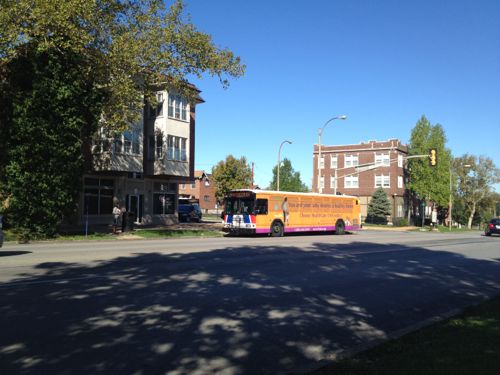

b

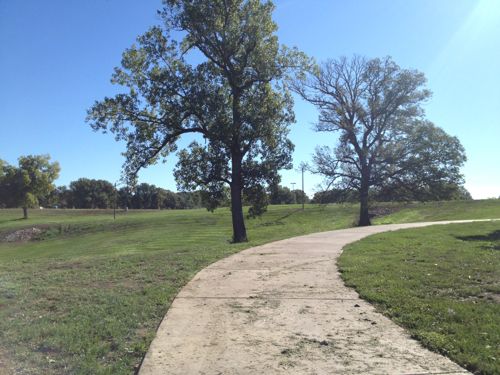
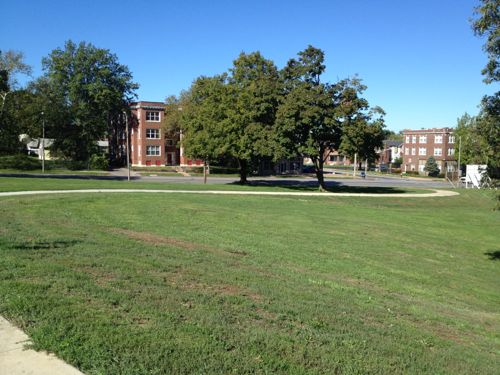
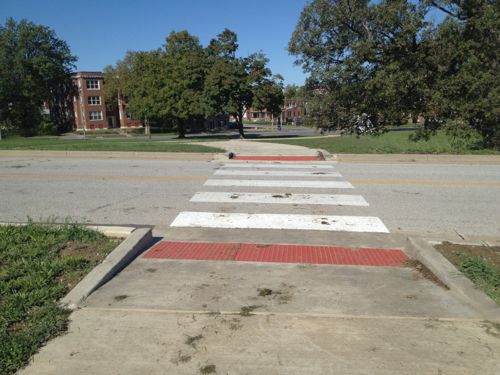

As the pictures above show, the pedestrian access from the nearby neighborhood, Florissant Ave. and MetroBus is excellent. A straighter path would be a shorter but not possible due to the grade change. Besides, if you’re going to work out saving a few steps probably isn’t a priority. Pedestrians just have to cross one internal park roadway, they don’t have to walk in it. Unless they are coming from or going to the O’Fallon Park Boathouse or if you live to the southeast of the park, across Harris & Adelaide Avenues, then access is tricky through the park or requires walking in the park roadway or going out to Florissant Ave and then back in.
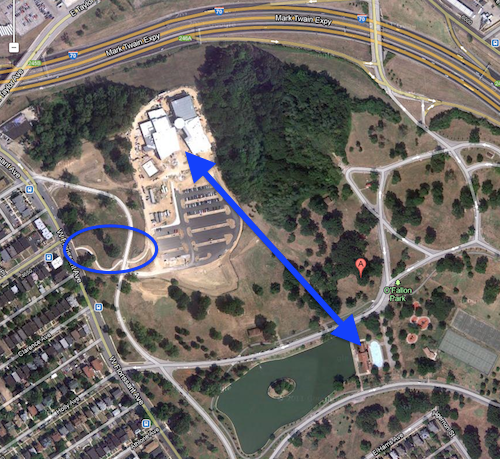

On to bicycling and driving. Cyclists can use the roadway so from that perspective their fine but I have serious issues with the bike rack selection and installation.
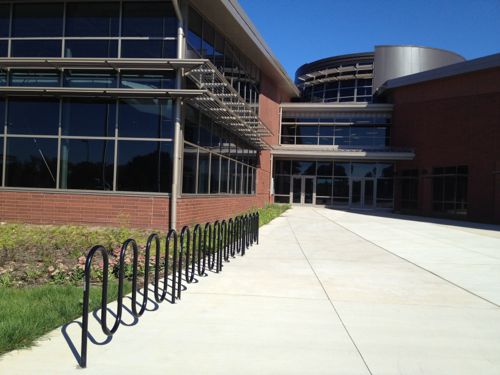
Architects love this bike rack design, even though it is a poor choice for securing a bike and most of the time they are installed incorrectly, as was the case here. When used as designed they can only secure the frame at one point, they should be loaded from both sides. The four racks shown here are designed to hold a total of 28 bikes. Another area with more of the same rack is to the left.
Better bikes racks would’ve been less expensive. Total failure on the part of the architects and/or client (city parks dept).
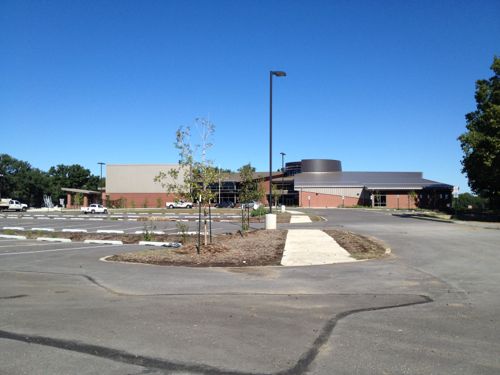

With the exception of the choice of bike rack and lack of connection to the O’Fallon Park boat house and adjacent tennis courts I’d say access is very good. It’s far better than trying to reach the sister facility in Carondelet Park from nearby neighborhoods.
— Steve Patterson
Ummm . . . wouldn’t pedestrian access have been much “better” if the whole structure had been placed next to Florissant Road instead of in the middle of the park?! This the classic suburban placement, with the building set back from the road and a sea of parking in front . . . .
Park structures are generally placed in parks, not at the perimeter. This is hardly the middle, it was the one open spot remaining. The suburban part is the large parking lot rather than parking along internal roadways.
So, any park “structure” is OK in any park, no matter where it ends up? The traditional park “structure” is a picnic shelter or a restroom structure, not something the size of a Walmart. And define “open spot”. The area between the “hump” in the park road and Florissant (where the oval is on your photo) appears to be another “open spot”. Why not put the structure there and put the parking across the park road (where it is now)? And leave the north end of the park as a natural area?
Agreed…but in this circumstance I think the placement makes since. Given that it’s a park they built the structure by the ugly and noisy Interstate. Eating up the least valuable and park-esque land.
Which then raises the question of why it was placed in a park in the first place? Park land is a finite resource. Why dedicate, what, 8% of this park to a “big box” and another 8% to surface parking? Why not use some of the vacant, non-park land the city already owns in north city? Why not structured parking, under the big box? Why give the city a “pass” on suburban-scale development while repeatedly criticizing similar developments in the private sector?
I’d have to look back in my archives but I think I voiced opposition to using park land for these large facilities. The city is the largest land owner in the city, sites could’ve been found that wouldn’t use open park land.
It was the cheapest, most available site. In South City, there isn’t the kind of vacant, city-owned land to work with, and the Carondelet Park Y set the precedent, opening the door to the O’Fallon Park Y. For comparison, look at all the problems stemming from the History Museum’s acquisition of vacant property on Delmar. What a mess, and now, environmental contaminants too!
I think the facility works in the park. The Y is a base for physical activity and the park is a great place to do that. Particularly in the context of a run or a bike ride. The wife and I regularly go to the Y afterwork, put our stuff in a locker and head out to the park for a run. When we return we do a class or a circuit with the weight machines and then head home. The location in/near a park works very well for this and there are plenty of other couples doing the same.
Additionally the Y is a great oasis for those just using the park. Everyone (membership or not) is free to come in and use the bathrooms, get a drink of water, warm up/cool down or take refuge from a passing storm.
I don’t know how safe crossing Florissant Ave is; people drive like bats out of hell on that street.
Just some observations, between Denver (pop. 620,000) and St. Louis (320,000):
Rec Centers – 30 in Denver versus 10 here.
Aldermen / City Council Members – 15 in Denver versus 28 here.
http://www.denvergov.org/recreation/FindaRecreationCenter/tabid/430474/Default.aspx
http://stlouis-mo.gov/government/departments/parks/recreation/
Denver also has a more rational and transparent pricing structure: http://www.denvergov.org/parksandrecreation/Recreation/MembershipsFees/tabid/442644/Default.aspx
Jim, what’s the point of this comparison?
Denver offers a more neighborhood-focused delivery of recreation services. These two new St. Louis centers are great if you live somewhere near one of the AND can afford the rates the Y charges. I live near Lindenwood Park, and the Carondelet Park Rec Center is 6 miles / 15 minutes (driving) / 50-60 minutes (by bus), while the O’Fallon Park Rec Center is 10 miles / 20 minutes (driving) / 80-90 minutes (by bus). Rates haven’t been published for the O’Fallon center, but the annual cost for me to use all the facilities at Carondelet would be $602 (12 x $46/mo + $50 pool fee). My nearest center, the Marquette Rec Center, is still 4 miles and 15 minutes away (driving) (and city doesn’t post its rates). Then there’s the reality that there are NO centers west of Kingshighway, although probably at least a third of the city’s residents live west of this major artery.
In contrast, when I lived in Denver, I was about a mile / less than 5 minutes away from three different rec centers, one regional one, one local and one neighborhood center. None were as opulent as either one of these, but both offered solid programs and facilities, and annual fees are currently $369, $249 or $190, respectively. My take is that St. Louis appears to be more focused on keeping up with the suburbs and providing photo ops for politicians than they are in delivering equitable services to all parts of the city. And the only reason I brought up the issue of the number of aldermen is that having 28 is always trotted out as a way for us to have “better representation” – this is one example of wildly varying outcomes . . . .
Denver and STL are vastly different cities in so many ways.
The current population density (and tax revenue) of NSTL does not support a scenario that would have all residents within a mile of a rec center. The City has built a modern facility to the standard that most other American metro communities now enjoy (and they have done so even for the city’s poorest families).
If you’re without a car, and transit takes too long, 6 miles can be covered by bicycle very quickly…and in STL you can do so nearly all year long.
The big difference is that the city here has ALL of its rec centers located east of Kingshighway, and NONE west of this major north-south artery. ALL city residents (and many non-residents) pay taxes to support the city’s 10 centers. The best solution would have been to build four $10 million centers instead of two $20 million centers – two in the current locations and two more, perhaps in Visitation and Francis Parks. I’m not worried about yuppies getting their workouts in, I’m concerned about youths of all economic strata having access to recreational activities within a reasonable distance of their homes. Reality check – most parents are not OK with their kids riding their bikes for 5 or 6 miles on city streets, nor are they willing to let their kids ride Metrobus for an hour each way! Yes we have finite revenues! That’s all the more reason why we shouldn’t be building Cadillacs when we can barely afford Chevies!
Some St. Louis Hills residents proposed to convert Nottingham School into a community center and plush swim club, paid for via a CID. They didn’t want to take space from Francis Park and they wanted to limit attendance to 16th ward residents. The plan died when the Board of Education wouldn’t part with Nottingham School and neighbors across the street didn’t like the idea.